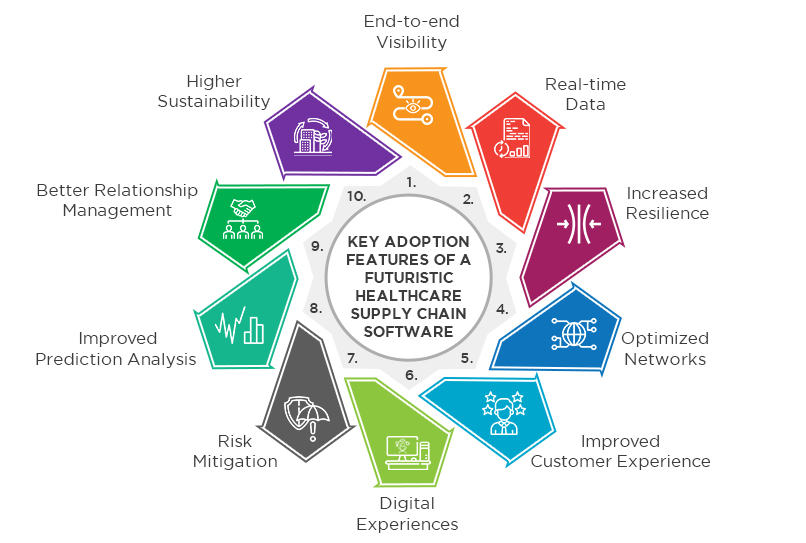With the onset of the COVID-19 pandemic, the supply chain in healthcare was forced to evolve at an unprecedented rate to keep up with the rapidly transforming demand dynamic. In healthcare, supply chain management witnessed a paradigm shift in the logistical landscape that forced healthcare organizations to look at innovation to survive. No longer will traditional legacy systems of supply chain manufacturing in healthcare be sufficient. Healthcare supply chain solutions of the new age need to adopt a resilient and robust framework to keep up with the demand of the new age. According to a recent study, almost 87% of supply chain organizations invest in innovative technology to boost their profitability.
At OSP, a US-based client was using another 340B management system. However, that system didn’t address the client’s evolving needs. The main task of the client was to have a complete healthcare supply chain management system to identify patient eligibility, manage inventory, provide real-time updates, manage distribution and tracking of drugs, and create agile reports.
Our customized solution offered:
- Easy to identify patient eligibility with a customized 340B management system integrated with other databases that store the data of 340B eligible patients
- EDI interfaces allow a direct exchange of data between the inventory and order management system and suppliers.
- Compliant inventory management to maintain multiple inventory centers and assimilate dispersed inventories into the pharmacy workflow.
- Optimized supply chain management with predictive analysis to predict the probability of inevitable consequences and provide real-time visibility into inventory purchasing.
- Advanced 340B reporting generation saves time and money and help clients view the benefits and forecast the future usage of medical supplies.
As you can see above, the innovation toward healthcare supply chain automation is the current norm. If you’re looking toward futuristic healthcare supply chain solutions, here’s a look at the critical features for 2023 and beyond.
Key Adoption Features of a Futuristic Healthcare Supply Chain Software

1. End-to-end Visibility
The current pandemic is a stark reminder of the importance of visibility in healthcare supply chain management software. A direct result of this is an awareness of the strengths and weaknesses, an analysis of how to control costs, and creating expansion plans. End-to-end visibility across the entire supply chain in healthcare promotes meaningful decision-making through data-driven insights. Clinical data analysis and clinical informatics can be built into the supply chain for all-rounded visibility. Forecasting transportation and other spending is a complex process and requires a significant amount of operational visibility. Accessibility to meaningful data can, therefore, play an important role in cost reductions.
2. Real-time Data
A recent survey found that almost 85% of healthcare supply chain companies agree that real-time data has successfully mitigated challenges across the entire value chain. Medical records management solutions can be applied to integrated healthcare solutions to extract vital data that aids in cost control, improves overall performance, bridges process gaps, and creates a seamless transition across the medical supply chain management. Healthcare supply chain software should work to provide real-time data analysis to improve the company’s bottom line. With remote work conditions being increasingly adopted, hospital materials management systems can be run seamlessly through access to real-time data.
3. Increased Resilience
While building a supply chain strategy for hospitals, leaders are increasingly recognizing its value towards driving profits. In the future, resilient medical supply software can be a game-changer for healthcare organizations. Just as practice management solutions control unnecessary costs, optimizing supply chain spending can offer maximum benefit. Hospital management systems can optimize their processes through healthcare interoperability that relies on the resilience of the supply chain operations. Finally, with enhanced visibility, data-driven decision-making, and maximum resilience, you can be assured of a particular shot position of advantage.
4. Optimized Networks
Disruptions in the supply chain strategy for hospitals and other healthcare avenues are witnessing a surge like never before. With electronic health records and mHealth solutions, even healthcare supply chain software should be set up on an omnichannel. A robust network should be adaptable to future disruptions, provide optimized performance and remain low on costs. As healthcare technologies continue to provide added features of improved diagnostics and imaging, the future supply chain will need to be integrated with healthcare manufacturing and medication dispensing processes through pharmacy management. Hospital inventory management, in the future, will be a small component of a host of services provided along with the same network.
5. Improved Customer Experience
A futuristic healthcare supply chain software will need to free itself from the geographical limits of the healthcare organization and adapt to the fluidity of reaching the patient to their specific location. As with other patient engagement systems, consolidation and collaboration will play a big role in supply chain management in healthcare. As hospitals look to reduce readmission rates and with major healthcare reforms, in-patient and out-patient facilities may be a thing of the past. Hospital supply chain management healthcare will have to move past the walls of the healthcare organization and allow patients to receive caregiving services wherever needed. Patient-oriented care, therefore, is based on a methodology to improve the customer experience. Through the probable use of electronic data exchange, healthcare consumers will look to buy healthcare products as with any other products.
6. Digital Experiences
Digitized healthcare supply chain software comes with the opportunity to deliver the right product to the right patient at the right time. Cloud computing in healthcare and healthcare analytics solutions has mastered the art of leveraging data toward improved decision-making. Similarly, a digital supply chain can offer advanced healthcare analytics and an increased connection between providers and patients. Through an intuitive digital experience, patients are encouraged to use the supply chain, and organizations can offer increased convenience to patients, providers, and other entities within the healthcare space. Finally, through HIPAA compliance, regulatory compliance can be maintained on a digital supply chain.
7. Risk Mitigation
Managing risks will be a big part of the future supply chain. With every technological disruption comes a new risk, and healthcare companies must have provisions to mitigate risks. Through integrated care management strategies and overall integrity, deployment should ensure dynamic risk assessment and mitigation. When patients suffer inconvenience due to lack of stock or other reasons, healthcare organizations risk losing patients. Customer service is automatically enhanced with the reduction and prompt management of risks.
8. Improved Prediction Analysis
As with other sectors, healthcare automation has enhanced prediction analysis across the entire healthcare lifecycle. Through real-time data and advanced analytics, predictive analysis can yield high-end results in healthcare supply chain management solutions. Reliable health forecasts can allow organizations to manage inventory accordingly and avoid shortages. Furthermore, based on these data analyses, high-quality reporting can provide patients with a superior caregiving experience through predictive analysis.
9. Better Relationship Management
Futuristic healthcare supply chain solutions will operate with increased visibility across the entire process flow on the supply chain. Processes are, thereby, optimized, and the relationship between the provider and patient grows in strength. Strong relationships between multiple healthcare entities increase the resiliency of the supply chain and make a stronger case for serving patients by offering patient-centric services. With advanced planning and inventory management, wastage and cancellations remain at a minimal level. In the end, the patient is happier, and so is the provider.
10. Higher Sustainability
A future healthcare supply chain platform will be environmentally conscious in its approach and through supply chain healthcare delivery. Eco-friendly supply chain practices with a high-end sustainability model are more likely to succeed in the long run. With strong data strategies and top-of-the-line technologies, sustainability is a feature that can be easily attained for additional profitability.
Conclusion
As you embark on your journey of supply chain strategy for hospitals or other healthcare organizations, rapid evolution should be the central idea of your development. As leading healthcare organizations embark on the innovation and technological adoption road, higher visibility, data quality, stronger relationships, and optimized processes will work as a successful map toward future profitability. Finally, a keen awareness of compliance requirements and flexibility for changes will provide a significant boost to your bottom line.
OSP is a trusted software development company that delivers bespoke solutions as per your business needs. Connect with us to hire the best talents in the industry to build enterprise-grade software.

How can we help?
Fill out the short form below or call us at (888) 846-5382
Looking for software solutions to build your product?
Let's discuss your software solutions for your product in our free development acceleration call!
Get In Touch arrow_forwardDiscuss Your Project Handover with a team of expert Book a free consultation arrow_forward
About Author

Written by Riken Shah linkedin
Riken's work motto is to help healthcare providers use technological advancements to make healthcare easily accessible to all stakeholders, from providers to patients. Under his leadership and guidance, OSP Labs has successfully developed over 600 customized software solutions for 200+ healthcare clients across continents.

















